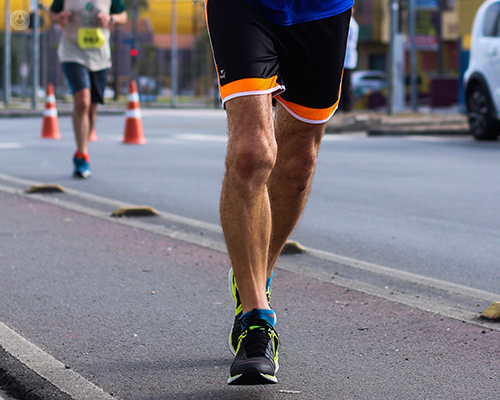Knee injections vs. knee replacement surgery: which is best?
Autore:Mr Rohit Jain, a leading London and Kent orthopaedic hip and knee surgeon, shares his professional medical knowledge to guide you through making a confident and well-informed decision on how to approach your knee joint treatment.

What is knee osteoarthritis?
A breakdown of cartilage leads to the process of osteoarthritis (OA). Cartilage is provided by Nature in all moving parts of the joint. It acts as a shock absorber and as a frictionless surface and this allows free and easy movement of the joint.
As this cartilage breaks down, the underlying bone goes through changes: it can harden as well as promote the formation of new bone and cysts within the joint. This leads to pain, swelling and crunching noises when the joint is moved, eventually leading to full-grown osteoarthritis.
How is osteoarthritis treated?
The options for managing osteoarthritis are activity modification, physiotherapy, braces, maintenance of a healthy body weight and painkillers. When these stop working- there are two main options for managing and treating the condition: knee injection therapy and knee replacement therapy. The choice of treatment really depends on how bad the patient’s pain, swelling and limitation of movement are, as well as how far the destruction within the bone/joint has gone as a result of OA.
What is knee injection therapy?
There are four broad categories of knee injections which can be used within the joint. They can be grouped into pain-relieving (steroid and hyaluronic acid) in which chemicals are injected into the knee, and orthobiologic (nStride and PRP) in which we harness the body’s ability to heal.
Steroid injection
Steroid injections have been used to treat knee osteoarthritis for several decades and are one of the most commonly used. It is a combination of local anaesthetic and a steroid. A steroid is predominantly an anti-inflammatory substance and it works by reducing the inflammation of the knee joint, therefore reducing pain and recurrence of swelling. The effect can last between six weeks to three months and in some cases, it can last up to six months.
Hyaluronic acid injection
Hyaluronic acid is a naturally occurring substance within the joint fluid. As the joint deteriorates, the quality of this joint fluid changes. The hyaluronic acid injection provides an introduction of the substance acid within the joint, which thereafter acts as a lubricant and can also improve the nutrition of existing cartilage.
PRP injections
PRP is an orthobiologic injection that harnesses the body’s ability to heal. Blood contains cells called platelets, which are mainly responsible for healing. For this injection, we take the blood from the patient and split the blood in a machine. We separate platelet-rich plasma (PRP) from the rest of the blood and then inject it into the joint. PRP creates a healing environment in the joint which can reduce pain and can maintain good cartilage health.
nStride ®
nStride® is a further advancement on the PRP injection. It has a much more refined structure and is a much more activated form of PRP. The nStride® orthobiologic injection has good proteins which restore the balance within the knee joint and has the potential of healing the cartilage and maintaining good health of existing cartilage. The effect can last for almost two years.
What is knee replacement therapy?
Knee replacement surgery (also known as knee arthroplasty surgery) is predominantly a resurfacing procedure. Think of it like resurfacing a patch of the road that is broken down and uneven.
Essentially, we map out the uneven knee and then we lay a new surface on it . We take away all the parts of worn-out cartilage and realign the joint with metal caps. Between these metal caps, we put high-grade plastic and this creates layers consisting of metal, plastic, and then metal again. By taking out the worn-out arthritic parts of the knee, the pain is taken away.
What are the risks of treatment methods?
Injection therapy is less invasive than knee replacement therapy, which is a major surgery.
Injection risks
Side effects are very minimal. There is a small risk of infection and bleeding, but this risk is no more than if you have a blood test done. There is only a 1 in 1000 risk of infection.
With all injections, there is the risk of residual or recurrence of symptoms and this is because injections are used to try to manage the problem, not to fix it – the injections assist in preserving the joint as long as possible.
Steroid injection
- These can interfere with blood sugar levels if a patient is diabetic .
- If the injection is very close to the skin, it can cause loss of pigmentation, but this is not common after a joint injection because joints are quite deep under the skin.
Hyaluronic injection
- Some patients can have an allergic reaction (about 1 in 100) but with modern forms of hyaluronic injections, this risk is even lower.
N-Stride and PRP
- These injections have the same risks as steroid and hyaluronic injections regarding pain, infection and bleeding. The advantage of these injections is that they are produced from your own body.
Joint replacement therapy risks
Joint replacement surgery will fix osteoarthritis in the knee by taking the pain away. Being a major surgery, there are risks:
- Pain
- Bleeding
- Infection
- Damage of nerves and vessels
- Blood clots in a leg or lung
A knee joint can take up to 12- 18 months to complete regain its strength and function. Approximately 15% of patients can complain of pain even after 18 months of the operation. The patient’s soft tissues, including muscles, have to adapt and strengthen to the new parts.
Who is suitable for either option?
Suitability for an injection or knee replacement really depends on the symptoms and the stage of osteoarthritis of each patient. We’re mainly looking at pain, swelling and a loss of function, as well as how much deformity from bone loss is present in the joint. We consider how bad the symptoms are, how bad the joint looks on x-rays and the age of the patient. We put all previously mentioned factors together and create a tailor-made and patient-specific treatment plan.
There is a larger role of injection therapy for
- Young people
- People who wish to preserve the knee
- People with mild or moderate osteoarthritis
If the joint shows a lot of deformity and bone loss, generally that joint is not suitable for injection treatment. In those cases, we tend to recommend a knee replacement.
It’s important to take into account that this is broadly speaking. To have the best tailor-made treatment, it’s best to get assessed by a knee specialist. We can go through various options which are suitable for you.
In your opinion, which option do you think is best for treating knee osteoarthritis?
In my opinion, treatment will depend on the extent of OA present in the knee. By large, other surgeons and I like to preserve the joint as much as possible. Once we have exhausted all joint preservation techniques, only then will we proceed to joint replacement. With younger people being more active, we see more of them coming in to try and preserve the knee joint. Most often, knee replacement patients are in the age group of 65 and above. Recent evidence shows that 82% of total knee replacements are still functioning at 25 years.
You can get in contact with Mr Jain to begin treating your hip and knee conditions. Begin your journey with him by visiting his profile.


